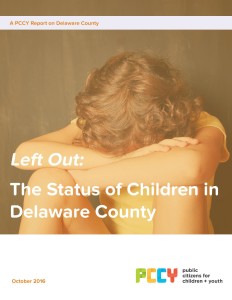Children Stuck in Recession in Suburban Counties Despite Recovery
Child poverty, lower test scores casts long shadow in Delco, Bucks, Montco and Chester
DOWNLOAD “Left Out–The Status of Children in Delaware County”
Philadelphia (Oct 3, 2016) – While recent headlines tout a national recovery from the Great Recession, more children in four suburban counties surrounding Philadelphia are worse off now than during the depths of the recession, according Public Citizens for Children and Youth. PCCY released the first of four reports on the status of children in Delaware, Montgomery, Bucks and Chester counties, titled, “Left Out: The Status of Children in Delaware County.”
More Children Are In Poverty than During the Recession
PCCY found that while the number of jobs and median incomes fully rebounded in each of the four counties, children were still suffering from the effects of the recession. The latest data shows that in 2015, slightly more than 48,000 children were living in poverty (the federal poverty level is defined as approximately $20,000 for a family of three) across the four counties. That’s 7,000 more children living in poverty than in 2009, when GDP was at its lowest and the unemployment rate peaked.
PCCY points out that nearly half of these children, or 22,610, were in families that were desperately poor (incomes at half the federal poverty level, or around $10,000 for a family of three). Here again, in spite of the overall economic rebound, the number of destitute children grew by more than 1,486 compared to 2009, or a 7% jump.
The Rebound for Seniors is Complete–Not So for Children
PCCY found that the recession not only pushed more children into poverty, but that public policies that could have protected children from this hardship were not in place. For instance, compared to seniors who have Medicare and Social Security to help them stay afloat, children had much less protection so they suffered more. In every county, the share of seniors living in poverty recovered to pre-recession levels much more quickly than it did for children in Montco, the only county that saw such a recovery. Meanwhile, in Bucks, Delaware and Chester counties, child poverty rates remain higher than in 2008 while the number of seniors in poverty dropped to below recession levels in all four counties.
Social Security & Medicare Helped Seniors Stay Afloat—What about Children?
The relative improvement for seniors compared to children hit home PCCY’s point that public policy is essential to helping protect children when their parents are not able to earn enough to meet their needs. For instance, because of publicly funded children health insurance programs, nearly all children in every county were insured and the recession had little impact on that critical health indicator. On the flip side, PCCY found that the public policies that boost working families’ incomes or expand investments in early childhood education, public schools and other child health services, were cut during the recession and as a result the status of children worsened.
Family Supports Are Weaker than Before the Recession
For instance, in all four counties fewer families could afford to enroll their children in high quality child care. Yet, as incomes tanked during the recession and the price of care rose, state subsidies to help families meet these costs were reduced. PCCY showed that in the last two years, good public policy has resulted in small increases in state funding for pre-k, but six out of ten children across the counties are left out of these programs due to the shortage of public investment.
Schools Are Educating More Poor Students with Fewer Funds for Instruction
PCCY also found that in every school district the share of children in poverty grew from 2008 to 2014, but due to state and federal funding cuts and state mandates, the districts with greatest percentage of poor children had fewer funds to spend on instruction in 2014 compared to 2008. As a result the percentage of students not able to pass state assessments rose across the four counties.
The New PCCY Child Wellness Index Shows Children in Every County Are Still Suffering the Impact of the Recession
PCCY’s new county series on the status of children relies on its newly created Child Wellness Index which examines four key areas to measure how children have fared since the start of the recession in 2008, including: economic well-being, health, early childhood education, and K-12 education.
Delaware County’s Index Shows Children are Mostly Doing Worse
PCCY released its report on Delaware County first because it consistently had the highest poverty rate for children compared to the other suburban counties. The Child Wellness Index for Delaware County shows that with respect to health care children were doing better than 2008, for early childhood they were doing about the same but educational resources and families incomes were significantly below the 2008 level.
###
READ “Left Out: The Status of Children in Delaware County”

